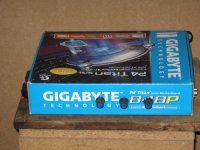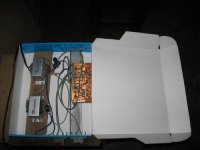Once you have bridged once, you have achieved the maximum voltage swing you can, therefore adding more parallel stages will only increase the current drive, making it easier to drive low impedance loads, it won't make the amp physically louder with the same typical 8 ohm speaker.
Bridge parellel amp
V*A=W simple but effective, volts times amps = watts, ie. a LM3875 will produce 56watts into an 8 ohm load with a +/- 35V supply. So if the amp is bridged each chip will see 140V swing. With the original amperage of each chip, or a theroretical 4* power gain 224watts, but that will far exceed the chips dissipation, limiting the overall output power to around 2*.
V*A=W simple but effective, volts times amps = watts, ie. a LM3875 will produce 56watts into an 8 ohm load with a +/- 35V supply. So if the amp is bridged each chip will see 140V swing. With the original amperage of each chip, or a theroretical 4* power gain 224watts, but that will far exceed the chips dissipation, limiting the overall output power to around 2*.
Cost per power will be better for higher power ICs , like LM3886 or so.
In our country cannot buy LM3886.
How much cost for that Chip?
In our country TDA2050 is below 0.9 US $.
TDA 2030 is below 0.4US $.
My price is cheap or not?
Once you have bridged once, you have achieved the maximum voltage swing you can, therefore adding more parallel stages will only increase the current drive, making it easier to drive low impedance loads, it won't make the amp physically louder with the same typical 8 ohm speaker.
Is 4ohm spk louder than 8ohm spk?
Because volts times amps = watts.
Watts increase mean louder.
Is it true or not?
Sorry for my poor english.
Ah how nice to see someone from Myanmar here. My wife went there a few times for business and she says they're a very friendly people.
TDA2030 - that's my childhood GC.
With 2 chips in bridge mode, you get up to 4X the power of a single chip. However, each chip sees half the load impedance so driving a 4ohm load is not advisable. You could however, as you mentioned, have 2 paralled pairs in bridge mode for a total of 4 chips. This adds extra complexity to ensure equal current sharing such as offset trim and/or precision output resistors.
Keep in mind that the bridge mode won't be noticeably louder. You'll need like 10 times the power to double subjective loudness.
Why not build a discrete design instead? You can easily scale that to any power level (within reason) and there are many true, tried and tested designs out there (e.g. Leach, Rod Eliot's amps, Slone's many amps). Some of them are not complicated and can provide better power and performance as compared to the TDA2030.
Back to your original question, if you want to know the real output power, you can measure the voltage developed across a load resistor.
TDA2030 - that's my childhood GC.
With 2 chips in bridge mode, you get up to 4X the power of a single chip. However, each chip sees half the load impedance so driving a 4ohm load is not advisable. You could however, as you mentioned, have 2 paralled pairs in bridge mode for a total of 4 chips. This adds extra complexity to ensure equal current sharing such as offset trim and/or precision output resistors.
Keep in mind that the bridge mode won't be noticeably louder. You'll need like 10 times the power to double subjective loudness.
Why not build a discrete design instead? You can easily scale that to any power level (within reason) and there are many true, tried and tested designs out there (e.g. Leach, Rod Eliot's amps, Slone's many amps). Some of them are not complicated and can provide better power and performance as compared to the TDA2030.
Back to your original question, if you want to know the real output power, you can measure the voltage developed across a load resistor.
Keep in mind that the bridge mode won't be noticeably louder. You'll need like 10 times the power to double subjective loudness.
Our ear can listen (Log) for Loudness.
Is that right?
Ah how nice to see someone from Myanmar here. My wife went there a few times for business and she says they're a very friendly people.
That's right.
But I am not myanmar.
I am chinese lived in myanmar & nationality is myanmar.
Back to your original question, if you want to know the real output power, you can measure the voltage developed across a load resistor.
I already tested tda2050BPA with scope when attached speaker 8 ohm ( 2spk inparallel )
Output voltage is max +/- 35~40 V in scope.
What watts of my amp?
If you can calculate, pls give me calculation method.
OR I must use 8ohm or 4ohm real resister (not speaker) for calculate watts?
Hello Friend,
My scope calibaration error.
Output voltage is max +/- 25~30 V.
My power supply drop to +/- 37V too.
Normal Power supply is +/- 45V.
Yesterday I tested with no load.( not attach spk )
Because I want to know maximum output voltage.
Voltage swing above 30V.
But My BPA burn out.
Why?
Pls, Help Me.
Output voltage is max +/- 35~40 V in scope.
My scope calibaration error.
Output voltage is max +/- 25~30 V.
My power supply drop to +/- 37V too.
Normal Power supply is +/- 45V.
Yesterday I tested with no load.( not attach spk )
Because I want to know maximum output voltage.
Voltage swing above 30V.
But My BPA burn out.
Why?
Pls, Help Me.
Output voltage is max +/- 25~30 V.
My power supply drop to +/- 37V too.
Normal Power supply is +/- 45V.
Um, did you mistype? Neither TDA2030 nor TDA2050 can withstand +/-45 rails. Max is +/-25V.
Um, did you mistype? Neither TDA2030 nor TDA2050 can withstand +/-45 rails. Max is +/-25V.
Output voltage is max +/- 25~30 V.
My power supply drop to +/- 16V too.
Normal Power supply is +/- 22.5V.
Sorry for mistake.
myanmar wrote:
OSCILLATIONS !!!
Yesterday I tested with no load.( not attach spk )Because I want to know maximum output voltage.
Voltage swing above 30V.
But My BPA burn out.
Why?
OSCILLATIONS !!!
Is that sure?OSCILLATIONS !!!
How can I test?
How can I protect?
How can I repair?
Another Bridge design
I already tested TDA2050 bridge amplifier with (TDA2030 bridge ST Design)
Circuit cannot work with TDA2050 ( supply voltage above +/- 20 V )
Only work at low supply voltage.
What is that problem?
Oscillation?
Pls, Help me.
- Status
- This old topic is closed. If you want to reopen this topic, contact a moderator using the "Report Post" button.
- Home
- Amplifiers
- Chip Amps
- Bridge Parallel AMP

